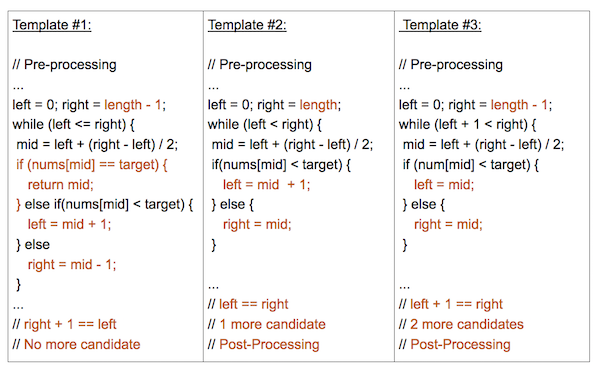Leetcodes的官方BS教程, 说分析了上百个案例,总结出三个BS模板 (需要注册才能看到链接)
大的方向需要三个部分:
3 Parts of a Successful Binary Search
Binary Search is generally composed of 3 main sections:
- Pre-processing - Sort if collection is unsorted.
- Binary Search - Using a loop or recursion to divide search space in half after each comparison.
- Post-processing - Determine viable candidates in the remaining space.
其中Template II
Template #2 is an advanced form of Binary Search. It is used to search for an element or condition which requires accessing the current index and its immediate right neighbor’s index in the array.
def binarySearch(nums, target):
"""
:type nums: List[int]
:type target: int
:rtype: int
"""
if len(nums) == 0:
return -1
left, right = 0, len(nums)
while left < right:
mid = (left + right) // 2
if nums[mid] == target:
return mid
elif nums[mid] < target:
left = mid + 1
else:
right = mid
# Post-processing:
# End Condition: left == right
if left != len(nums) and nums[left] == target:
return left
return -1
然后总结了4点:
Key Attributes:
- An advanced way to implement Binary Search.
- Search Condition needs to access element’s immediate right neighbor
- Use element’s right neighbor to determine if condition is met and decide whether to go left or right
- Gurantees Search Space is at least 2 in size at each step
- Post-processing required. Loop/Recursion ends when you have 1 element left. Need to assess if the remaining element meets the condition.
并在后续章节中对三种方法进行总结:

按照pre-processing, binary-search, post-search三段论.
拿出来Template II, 是因为这种方法最常用, 尤其是处理leftmost, rightmost, closet 问题.
笑点来了,
Leetcodes有模有样的用范式的三段论, 最后的的Post-processing 是画蛇添足.
def binarySearch(nums, target):
"""
:type nums: List[int]
:type target: int
:rtype: int
"""
if len(nums) == 0:
return -1
left, right = 0, len(nums)
while left < right:
mid = (left + right) // 2
if nums[mid] == target:
return mid
elif nums[mid] < target:
left = mid + 1
else:
right = mid
# Post-processing:
# End Condition: left == right
# if left != len(nums) and nums[left] == target:
# return left
# 全部去掉, 一样能完美工作.
return -1